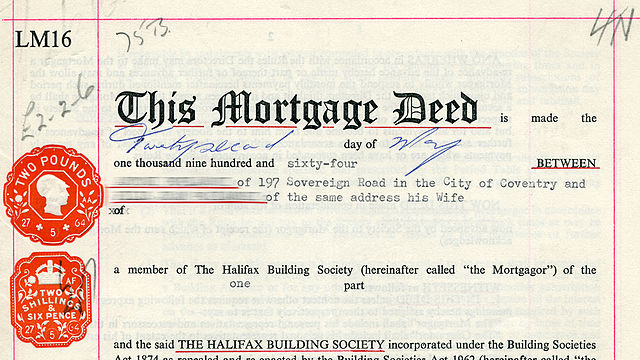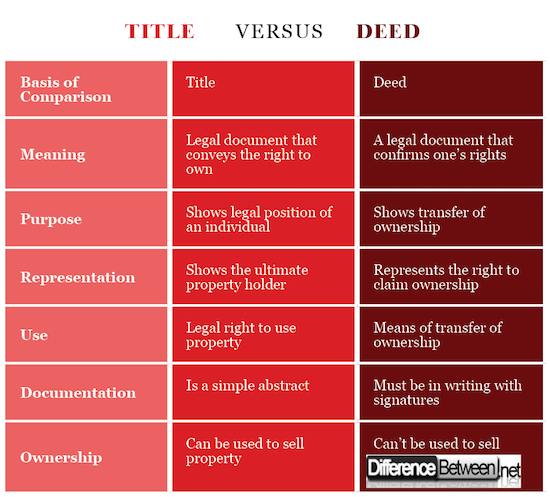Difference Between Deed and Title
Most people are used to the term title deed, and this has led to the assumption that they are the same thing. However, these two represent different legal concepts. Property owners possess both the Deed and the title. It is therefore important to understand the relevance of each document to avoid a mix-up.
Title shows that an individual owns property legally. In real estate, owning a title is crucial because it shows ownership of a property. This means that the individual with the title has the right to use the property. They can also transfer their ownership to other people when they want to. However, if they have partial ownership of the land, they can’t transfer more than they own.
Deeds are legal documents which show transfer of ownership from one individual or entity to another. According to the Statute of Frauds, they should be in the form of a written report. In addition to this, the documents should be recorded to ensure they are fully binding. They should also be filed for easy retrieval.

What is Title?
This is a legal document that espouses the right of an individual to own and possess the items that the document shows. In simple terms, it is a document that recognizes the ownership of items by people. They can be obtained by descent, grant and purchasing them.
There are many types of titles, but most people obtain personal property titles and real property titles.
-
Personal Property Titles
This type of title allows individuals to own property that is not in the real property category. It has two dominant categories. The first category involves property that is tangible. Such items include merchandise and jewelry among others. On the other hand, there is personal property that is not tangible and is referred to as incorporeal tangible material. Copyrights and stock fall under this category.
-
Real Property Titles
Real property entails items like cars and real estate. Therefore, real property titles show the ownership of the assets. Enlisted below are some of the forms in which real estate titles may take.
-
Tenancy in common
This shows that two or more people jointly own a real estate title. They, however, have a title of the piece of land they own individually.
-
Tenancy by entirety
This title is given to a legally married couple to show that they own property as one individual. If one spouse passes on, ownership is transferred to the living spouse.

What is a Deed?
This is a document that shows the transfer of ownership of property from a seller (grantor) to the end buyer (grantee). For the deed to have recognition in court and be functional, it must have the identification details of the buyer and seller as well as a comprehensive description.
Essential Features of a Deed
- It must be a written document.
- The grantor must meet the legal requirements to transfer the property, and the buyer should be capable of acquiring the property.
- The property should have sufficient description.
- It must contain the signatures of both the grantor and the grantee.
Just like titles, deeds have several classifications. They can be either private or official. Official deeds must be handed over in court, therefore, there have to be legal proceedings. However, most individuals or business entities carry out their transactions with private deeds.
Some of the common deeds include special warranty deed, special purpose and general warranty deed among others. This is a sensitive document. Therefore, an attorney should be consulted when carrying out transactions that involve the transfer of property.
Differences Between Title and Deed
1. Purpose of Title vs Deed
A deed is a legal document that shows the transfer of ownership of property from one party to another. On the other hand, a title is a name that is used to show an individual’s legal position regarding the property in question.
2. Representation of Title vs Deed
A deed represents the right of an individual to claim ownership of property. A title, on the other hand, shows who the ultimate holder of the property is.
3. Type of Legal Instrument in Title vs Deed
While a deed is a legal instrument that shows the means of transfer of ownership of property, a title shows the legal right of a person to use the property. Therefore, they differ in how they are used.
4. Documentation of Title vs Deed
A deed must be presented in writing, and it must have the signatures of both the grantor and grantee. A title, on the other hand, is just an abstract.
5. Ownership Rights in Title vs Deed
A title can be used to sell the property because it shows that the owner is selling it. A deed, on the other hand, can’t be used in selling the property because it shows the transfer of ownership rights.
Title vs. Deed: Comparison Table to illustrate the difference between title and deed

Summary of title and deed
Most of the time, the words title and deed are used together, and that is why individuals mistake them for one thing. They may be related but they are different, and they do not serve the same purpose. A deed shows the transfer of ownership of property from one person to another. Examples of properties that can be transferred include land and cars. A title, on the other hand, is a mere representation of the ultimate holder of the property. It is a legal instrument that describes the holder of the property. Therefore, it is an essential requirement of property owners to have a title.
- Difference Between S Corp and C Corp - September 9, 2018
- Difference Between Terrace and Balcony - September 9, 2018
- Difference Between Anabaptists and Evangelicals - August 31, 2018
Search DifferenceBetween.net :
1 Comment
Leave a Response
References :
[0]O'Connor, E. Rory (1987). The Irish Notary. Dublin: Professional Books.
[1]American Bar Association. (1995). The American Bar Association guide to home ownership: the complete and easy guide to all the law every homeowner should know.
[2]Ferara LN, Philips J, Runnicles J. (2007). Jones Day Publication
[3]Image credit: https://pixabay.com/en/savings-real-estate-mortgage-bond-440782/
[4]Image credit: https://upload.wikimedia.org/wikipedia/commons/thumb/d/d4/Legal_stamps_%E2%80%93_1964_mortgage_deed.jpg/640px-Legal_stamps_%E2%80%93_1964_mortgage_deed.jpg

I very with this explanation I really appreciate may God bless u a million times